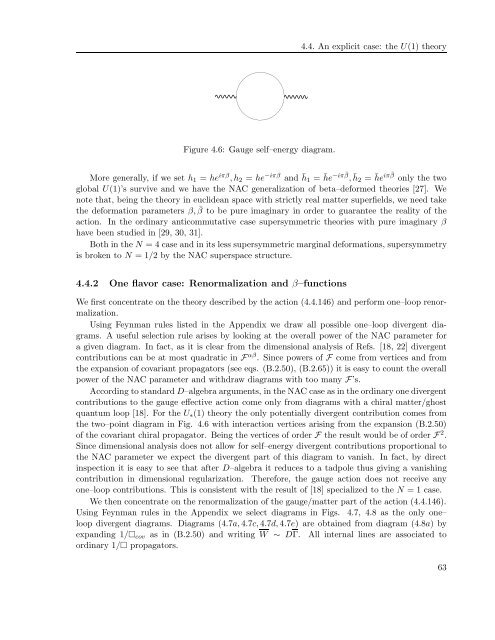Perturbative and non-perturbative infrared behavior of ...
Perturbative and non-perturbative infrared behavior of ...
Perturbative and non-perturbative infrared behavior of ...
You also want an ePaper? Increase the reach of your titles
YUMPU automatically turns print PDFs into web optimized ePapers that Google loves.
Figure 4.6: Gauge self–energy diagram.<br />
4.4. An explicit case: the U(1) theory<br />
More generally, if we set h1 = he iπβ ,h2 = he −iπβ <strong>and</strong> ¯ h1 = ¯ he −iπ ¯ β , ¯ h2 = ¯ he iπ ¯ β only the two<br />
global U(1)’s survive <strong>and</strong> we have the NAC generalization <strong>of</strong> beta–deformed theories [27]. We<br />
note that, being the theory in euclidean space with strictly real matter superfields, we need take<br />
the deformation parameters β, ¯ β to be pure imaginary in order to guarantee the reality <strong>of</strong> the<br />
action. In the ordinary anticommutative case supersymmetric theories with pure imaginary β<br />
have been studied in [29, 30, 31].<br />
Both in the N = 4 case <strong>and</strong> in its less supersymmetric marginal deformations, supersymmetry<br />
is broken to N = 1/2 by the NAC superspace structure.<br />
4.4.2 One flavor case: Renormalization <strong>and</strong> β–functions<br />
We first concentrate on the theory described by the action (4.4.146) <strong>and</strong> perform one–loop renormalization.<br />
Using Feynman rules listed in the Appendix we draw all possible one–loop divergent diagrams.<br />
A useful selection rule arises by looking at the overall power <strong>of</strong> the NAC parameter for<br />
a given diagram. In fact, as it is clear from the dimensional analysis <strong>of</strong> Refs. [18, 22] divergent<br />
contributions can be at most quadratic in F αβ . Since powers <strong>of</strong> F come from vertices <strong>and</strong> from<br />
the expansion <strong>of</strong> covariant propagators (see eqs. (B.2.50), (B.2.65)) it is easy to count the overall<br />
power <strong>of</strong> the NAC parameter <strong>and</strong> withdraw diagrams with too many F’s.<br />
According to st<strong>and</strong>ard D–algebra arguments, in the NAC case as in the ordinary one divergent<br />
contributions to the gauge effective action come only from diagrams with a chiral matter/ghost<br />
quantum loop [18]. For the U∗(1) theory the only potentially divergent contribution comes from<br />
the two–point diagram in Fig. 4.6 with interaction vertices arising from the expansion (B.2.50)<br />
<strong>of</strong> the covariant chiral propagator. Being the vertices <strong>of</strong> order F the result would be <strong>of</strong> order F 2 .<br />
Since dimensional analysis does not allow for self–energy divergent contributions proportional to<br />
the NAC parameter we expect the divergent part <strong>of</strong> this diagram to vanish. In fact, by direct<br />
inspection it is easy to see that after D–algebra it reduces to a tadpole thus giving a vanishing<br />
contribution in dimensional regularization. Therefore, the gauge action does not receive any<br />
one–loop contributions. This is consistent with the result <strong>of</strong> [18] specialized to the N = 1 case.<br />
We then concentrate on the renormalization <strong>of</strong> the gauge/matter part <strong>of</strong> the action (4.4.146).<br />
Using Feynman rules in the Appendix we select diagrams in Figs. 4.7, 4.8 as the only one–<br />
loop divergent diagrams. Diagrams (4.7a,4.7c,4.7d,4.7e) are obtained from diagram (4.8a) by<br />
exp<strong>and</strong>ing 1/cov as in (B.2.50) <strong>and</strong> writing W ∼ DΓ. All internal lines are associated to<br />
ordinary 1/ propagators.<br />
63
















